There's a lot to consider when selecting new pots and pans, and stainless steel vs nonstick cookware is one of the most significant decisions. Of course, it all comes down to personal preference and what foods you cook most often, but how do you choose?
Understanding the pros and cons of both options can help you make an informed decision. Next, you'll want to compare the two types of cookware to determine which would work better in your kitchen and your cooking style.
With expert advice and a no-nonsense approach, this guide is designed to help you decide. And you might improve your cooking game in the process. So, keep reading to learn more.
Stainless Steel Cookware
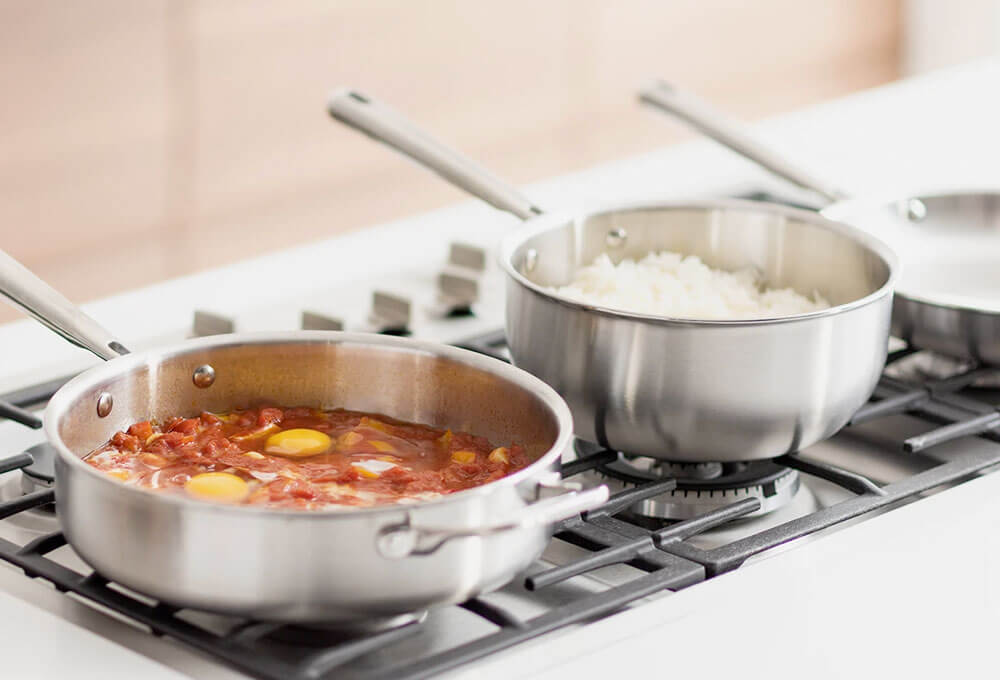
Uncoated stainless steel pans are the workhorses of professional and home kitchens alike. They’re generally made with an aluminum or copper core for even heat conduction. The core is coated in stainless steel for a nonreactive finish.
You want a pan with a heavier bottom to allow for maximum, even heating—thin and light pans are more likely to have hot spots and are less durable. Ideally, you’ll also want an ovenproof stainless steel pan with a handle with an oven-friendly coating. This makes baked dishes easier to cook while adding versatility.
Benefits of Stainless Steel Cookware
Stainless steel is the go-to choice for most professional chefs (even those who also use nonstick), and it has many benefits.
“Stainless steel has been around for a long time, and for good reason, it's reliable. You won’t have to worry about them rusting or losing their coating and can safely be washed in the dishwasher,” explains Devan Cameron, chef and owner of Braised & Deglazed.
“Stainless steel has been around for a long time and for good reason, it's reliable."
“In my experience,” continues Cameron, “they also seem to do a better job of searing and browning meats than nonstick pans. Plus, stainless steel pans can safely be used in the oven, perfect for cooking larger cuts of meat. Stainless steel pans are the way to go for braising, poaching, blanching, or any liquid cooking because you don’t have to worry about losing the nonstick coating.”

“Stainless skillets are incredibly durable, resistant to high temperatures, and will last a lifetime,” explains Jen Coleman from cookware brand Misen, which offers a range of stainless steel pots and pans. “Stainless skillets can cook 90% of the foods you'll ever make. The downside is that cleanup takes more elbow grease than a typical nonstick, though it is dishwasher safe.”
Stainless steel cookware can also be nonstick. "If you heat up your pan with butter or oil until it's hot enough, then add the ingredients, they won't stick,” adds Ligia Lugo, Culinary Expert and Founder of The Daring Kitchen.
Pros:
- Dishwasher safe
- More durable and won’t lose their coating over time
- Better for searing and browning meats
- Great for sautéing
- Oven safe at high temperatures
- Can be nonstick when oiled and heated properly
- Safe to use with sharp and metal utensils
- High durability and can last a lifetime
Downsides of Stainless Steel Cookware
Despite being a professional favorite, stainless steel is not without its flaws. A novice chef may find a stainless steel pan frustrating until they learn the ropes in the kitchen.

“One of the downsides is that you must be more careful when using stainless steel cookware,” explained Lugo. “You need to add oil and heat them properly. Cleaning stainless steel is also harder than cleaning nonstick pans as brown or burnt pieces of food can be hard to clean.”
Cons:
- Must be oiled and heated properly
- Can be more challenging to clean
- Requires more care and attention during cooking to prevent sticking or burning
- It is not ideal for foods that stick easily, like eggs/omelets, delicate fish, crepes, or soft tofu
- It can be more expensive than nonstick options
Nonstick Cookware
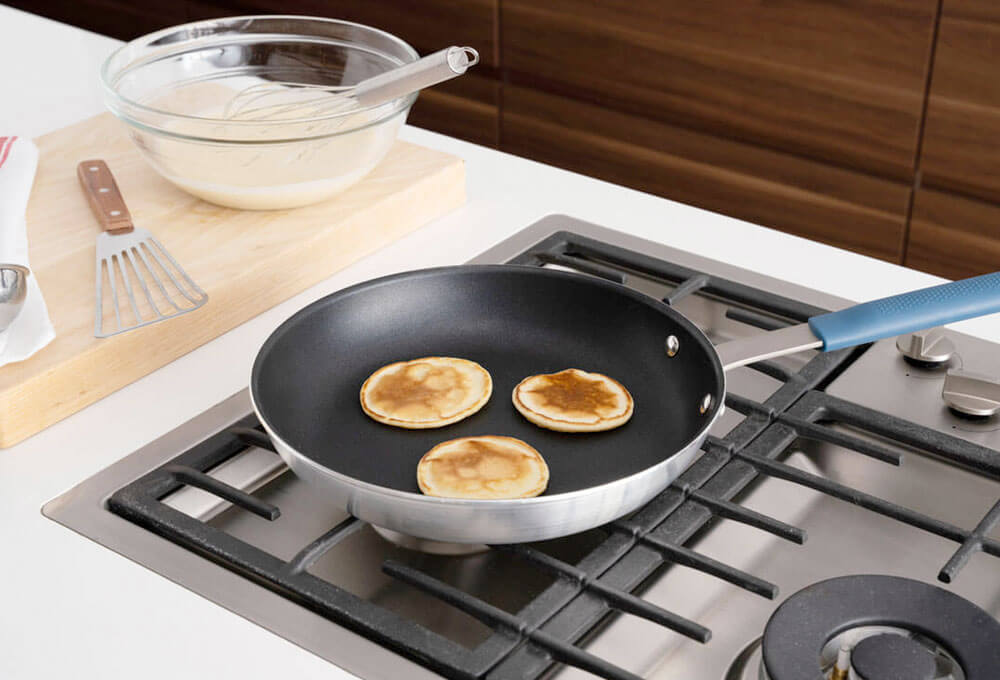
Most nonstick pans are made with an aluminum core and coated with a nonstick material like ceramic, PTFE or PFOA-free Teflon. Just like stainless steel pans, you want a heavier, thicker bottom for even heat distribution across the cooking surface, as well as an oven-friendly handle.
With nonstick, you’ll need to check how much heat the frying pan can take (most have a limit of 400 degrees F) and avoid going over that number. Cooking at too high of a temperature can damage the pan and the food you’re cooking.
Benefits of Nonstick Cookware
Nonstick cookware has its place in most professional kitchens, and many home chefs prefer it. As the name implies, you won’t have to worry about your food sticking to the pan and ruining your dish. And modern nonstick or ceramic cookware is generally considered safe when used properly.

“Nonstick pans are my first choice for cooking delicate foods like eggs and fish because they prevent food from sticking to the pan,” commented Cameron. “Generally speaking, I'd say a stainless steel cookware set is for more serious chefs looking for cookware that offers longevity, flexibility, and performance and is willing to pay for it with both dollars and maintenance,” added Peter Lipson of Kitchenda.
“The most obvious advantage is the nonstick coating, which prevents food from sticking to the pan,” added Lugo. “Nonstick cookware is very convenient due to its easy cleaning of the nonstick coating. Also, high-quality nonstick pans are generally a little cheaper than the stainless steel options.”
“Nonstick cookware is very convenient due to its easy cleaning of the nonstick coating. Also, high-quality nonstick pans are generally a little cheaper than the stainless steel options.”
“A quality nonstick pan is the easiest cookware to use. It's great for stick-free cooking and easy cleanup,” said Coleman. “The disadvantage is that nonstick pots and fry pans can't sustain high temperatures and won't last a lifetime. No matter what, all nonstick pans eventually stop working when the coating wears off.”
Pros:
- Ideal for delicate foods like fish, eggs, and tofu
- Prevents food from sticking to the pan
- Can be more affordable than stainless steel options
- Convenient and easy to clean
- Easier to use for beginner chefs
Downsides of Nonstick Cookware
While modern nonstick cookware is generally considered safe, it has drawbacks. And if you’re looking for a purchase that’ll last a lifetime, nonstick cookware isn’t it.
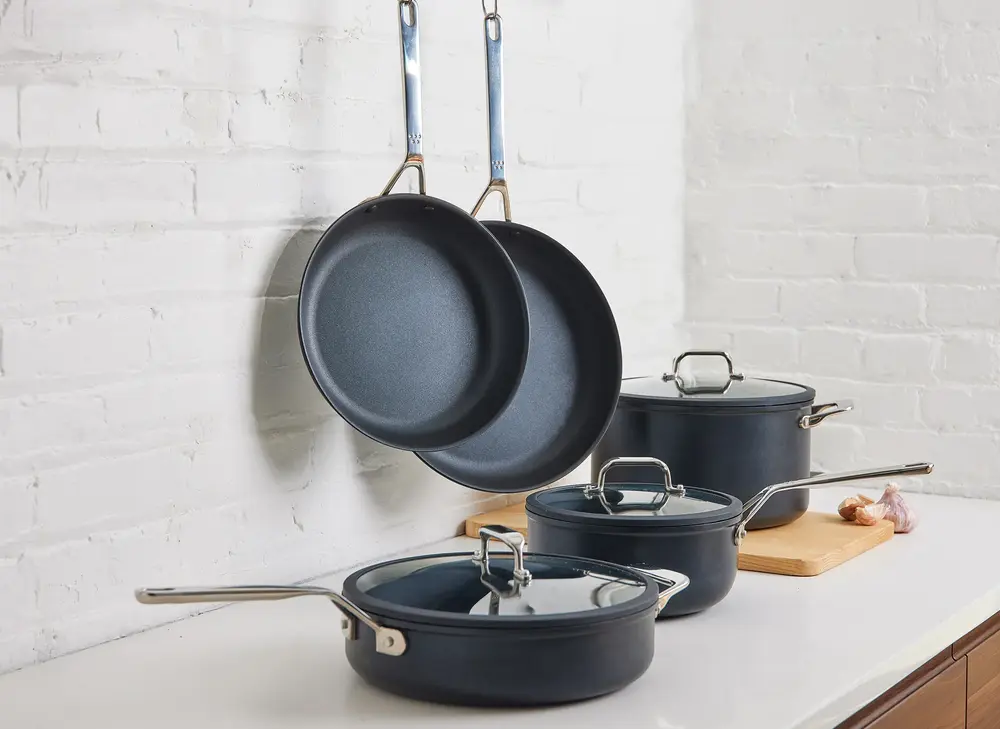
“The downside to nonstick pans is that they are high maintenance and need to be stored carefully to prevent the nonstick coating from deteriorating,” Cameron told Living Cozy. “Another problem with nonstick pans is that they can't go in the oven. The delicate nonstick coating will break down from the high heat of the oven. You also can’t use metal utensils like whisks, spoons or spatulas with nonstick pans as they’ll also break down the coating.”
“Nonstick pans are less durable, and the coating can chip. You should avoid using sharp utensils,” commented Lugo. “You won't be able to sear or brown foods on high heat the way you would with stainless steel.”
Cons:
- Less durable than stainless steel, and the coating can scratch or chip
- Cannot use sharp or metal utensils (silicone utensils are best for nonstick pots and pans)
- Requires careful storage, use, and cleaning to protect the nonstick coating
- Can be damaged by high heat and is not always oven safe (best in low heat and medium heat)
- Won’t last a lifetime—the coating will eventually wear away and stop working
Stainless Steel vs. Nonstick Cookware: Which is Best for You?

“I would advise that any home cook should have at least one or two nonstick pans for cooking foods that stick to the pan like eggs but invest in a stainless steel cookware set for the rest of the cooking,” Lugo explained, and we agree.
“I would advise that any home cook should have at least one or two nonstick pans for cooking foods that stick to the pan like eggs but invest in a stainless steel cookware set for the rest of the cooking.”
Nonstick cookware is a great fit for the more casual cook who values their time,” shared Lipson. “Stainless steel cookware does not have nonstick coatings. In general, they are on opposite sides of the spectrum and aimed at different buyers.”
"Most nonstick sets are built with aluminum offering quick heat conduction, while the nonstick surface provides easy cooking and fast clean up,” added Lipson.
If you’re passionate about home cooking, you’ll probably want to own stainless steel and nonstick cookware. But it definitely varies from chef to chef. You can start with one of each and, from there, it'll be easier to decide where to put your money. For example, you might want a complete set of stainless steel with one or two nonstick pans or prefer the opposite.
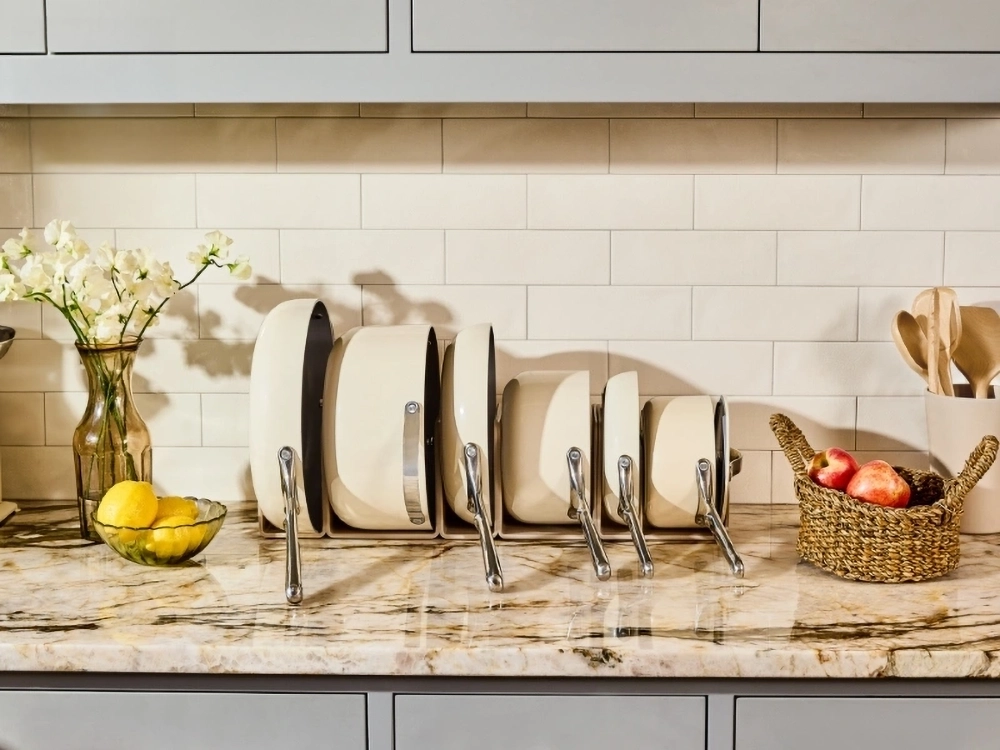
“You can't go wrong with either choice! It really comes down to your personal preferences in the kitchen,” Coleman told Living Cozy. “If you want a pan that can sear at high temperatures on the stovetop and the oven, stainless steel is the best choice. If easy cleanup is more important to you, nonstick may be a better choice, especially if you're mostly cooking eggs and fish.”
Taking a local cooking class could allow you to try stainless steel and nonstick cookware firsthand before buying. This is a great option for beginners struggling to decide what's best. Plus, it’ll teach you valuable skills!
Where to Buy Stainless Steel and Nonstick Cookware
If you're wondering where you can buy the best cookware, here are a few places to try:
Misen
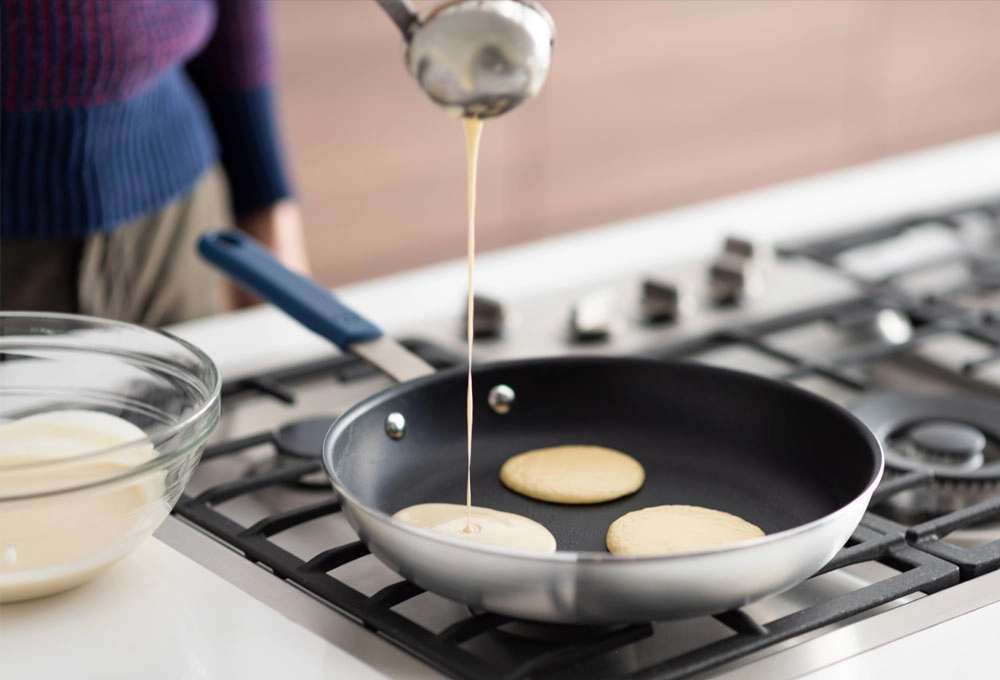
Misen is a cookware and kitchen brand from New York City. The brand's mission is to deliver better tools for better cooking at a reasonable price. Misen offers a range of stainless steel and nonstick cookware, an Enameled Cast Iron Dutch Oven, and famous chefs' knives and cooking accessories.
Read more:
Check out our review of Misen's nonstick frying pan here
Reviewing Misen's $148, 2-in-1 Dutch Oven
Material Kitchen

Founded in 2018, Material Kitchen offers professional kitchenware products that are great for home cooking and welcome in Michelin-star restaurants. Over 100,000 home cooks use its products, and it has a range of stainless-clad and nonstick frying pans, sauté pans, saucepans, and more.
Caraway
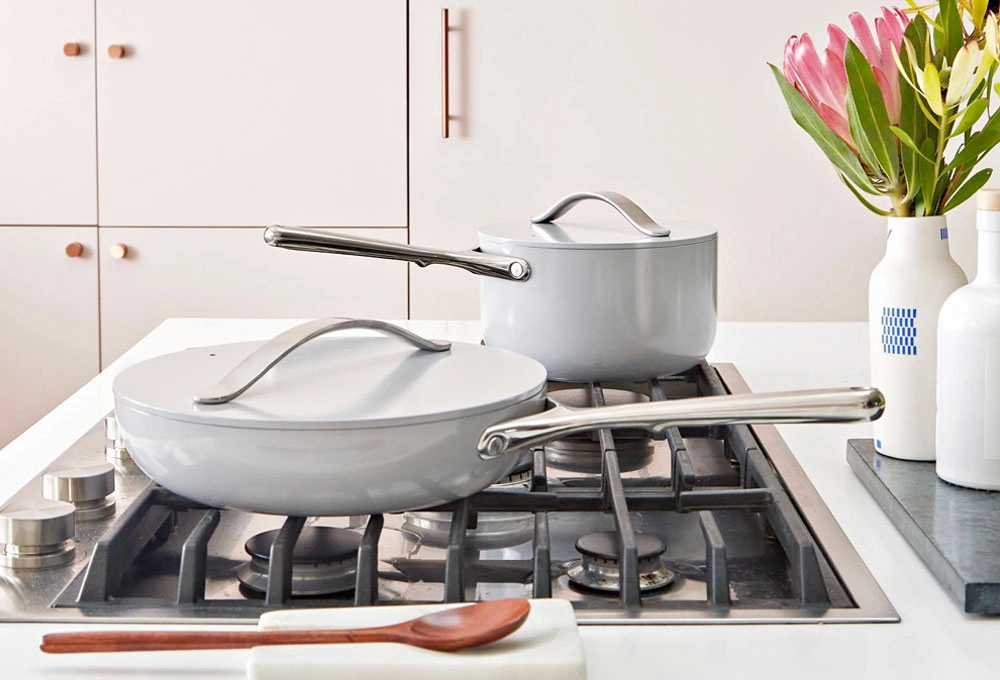
Caraway offers home chefs a healthier way to cook. Its ceramic-coated aluminum nonstick cookware won’t leak any toxins into your food. Its products are designed to make your life easier and more nutritious, no matter your level of expertise in the kitchen.
Other Cookware Brands
Other cookware brands worth checking out include All-Clad and Calphalon, which are more expensive, higher-end brands (both available on Amazon). At the slightly cheaper end of the scale, there's also T-fal and Cuisinart. These brands offer both stainless steel and non-stick options.
















